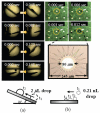Microfluidic systems for biosensing
- PMID: 22163570
- PMCID: PMC3231127
- DOI: 10.3390/s100706623
Microfluidic systems for biosensing
Abstract
In the past two decades, Micro Fluidic Systems (MFS) have emerged as a powerful tool for biosensing, particularly in enriching and purifying molecules and cells in biological samples. Compared with conventional sensing techniques, distinctive advantages of using MFS for biomedicine include ultra-high sensitivity, higher throughput, in-situ monitoring and lower cost. This review aims to summarize the recent advancements in two major types of micro fluidic systems, continuous and discrete MFS, as well as their biomedical applications. The state-of-the-art of active and passive mechanisms of fluid manipulation for mixing, separation, purification and concentration will also be elaborated. Future trends of using MFS in detection at molecular or cellular level, especially in stem cell therapy, tissue engineering and regenerative medicine, are also prospected.
Keywords: MEMS; Micro total analysis systems (μTAS); droplet-based; drug delivery; lab-on-a-chip; microfluidic; stem cell; tissue engineering.
Figures










References
-
- Squires TM, Quake SR. Microfluidics: fluid physics at the nanoliter scale. Rev. Mod. Phys. 2005;77:977–1026.
-
- Weibel DB, Whitesides GM. Applications of microfluidics in chemical biology. Curr. Opin. Chem. Biol. 2006;10:584–591. - PubMed
-
- Breslauer DN, Lee PJ, Lee LP. Microfluidics-based system biology. Mol. Biosyst. 2006;2:97–112. - PubMed
-
- Hong J, Edel JB, deMello AJ. Micro-and nanofluidic systems for high-throughput biological screening. Drug Discovery Today. 2009;14:134–146. - PubMed
Publication types
MeSH terms
LinkOut - more resources
Full Text Sources
Other Literature Sources
Miscellaneous

